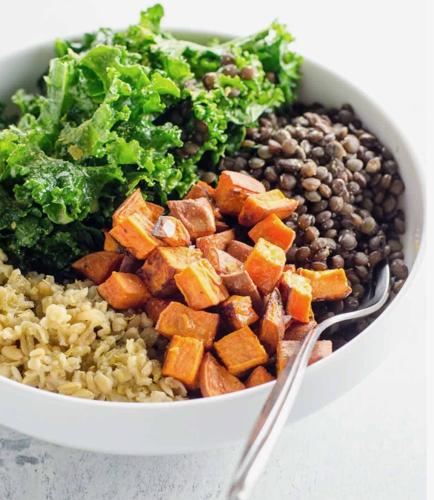The American Heart Association (AHA) designated February as the National Heart Health Month. AHA has identified seven factors, several of which are related to diet, that impact health and quality of life. A heart-healthy diet requires a balance of fiber-rich carbohydrates (40 to 45 percent of daily calories), healthy fats (30 to 35 percent of daily calories) and protein.
Protein takes time and energy to digest, so it can help you feel full and keep calories at a level for a healthy weight. When combined with healthy carbohydrates, it can modulate blood sugar levels. Fiber from protein-rich plant foods can help reduce unhealthy cholesterol levels.
Amino acids (20 in all) are the building blocks of protein. The body uses them for protein synthesis and to create other vital nitrogen-containing compounds, such as creatine, peptide hormones and neurotransmitters. But how much protein do you need?
The recommended daily intake for people over 65 is 0.45 to 0.55 grams of protein per pound or about 68 to 83 grams for a 150-pound person. You can do a simple calculation to estimate your protein needs. Divide your weight by two. Thus, your 160-pound friend would need around 80 grams daily, or about 27 grams of protein at each meal. What foods provide protein?
All whole foods provide protein. People are often surprised to learn that three ounces of cooked chicken and one cup of cooked lentils are nearly equal in their protein content. For heart health, more often choose protein foods from plants (beans, peas, lentils, nuts, seeds, tofu), which provide more fiber and less saturated fat than animal-derived options. You can try the Buddha Bowl recipe on this page, adjusting the ingredients to your taste and dietary preferences. Those who follow a plant-exclusive diet need to take in a variety of plant foods to ensure they get all essential amino acids. Omnivores should select lean meats, poultry, eggs and fish more often than burgers, rib-eye and pork ribs.
So, how can our hypothetical 160-pound friend fill their protein needs? Below are two options showing total daily protein and per meal (in parentheses).
Option 1Provides 91 grams of protein.
Breakfast (26g): 5.5 ounces low or nonfat Greek yogurt, 1 cup cooked oats, 1 cup berries, 2 tablespoons chopped walnuts.
Lunch(21g): Buddha Bowl
Dinner(26g): Roasted Fennel with Tofu and Oranges with ½ cup cooked quinoa. Chocolate avocado mousse.
Snack(5g): ¼ cup roasted chickpeas.
Option 2Provides 93 grams of protein.
Breakfast (30g): 2 scrambled eggs, 2 slices of whole wheat toast with 2 T old-fashioned peanut butter, and ½ large grapefruit.
Lunch(24g): Southwest Chicken Salad
Dinner(27g): 3 ounces of cooked salmon, 4 ounces of roasted potato, 1 cup of roasted Brussels sprouts and carrots.
Snack or Dessert (12g): ½ cup Greek yogurt and ½ cup fruit.
The recipe for Roasted Fennel with Tofu and Oranges is available on the Meatless Monday website, where you can find a wealth of plant-based recipes. For heart-healthy recipes with or without animal-derived protein, eatingwell.com is an excellent resource. They even have a category of healthy dinners for two.
Buddha Bowl
Makes four servings.
Ingredients
½ pound sweet potatoes, cut into 1-inch pieces
2 Tablespoons extra virgin olive oil, divided
2 small zucchinis, diced
1 cup finely chopped yellow onion (about 1 medium)
2 cloves garlic, minced
2 cups cooked brown rice or other whole grain
3 cups cooked brown lentils or chickpeas (canned if you prefer)
1 tsp curry powder
1/2 tsp Kosher salt, divided (estimated for nutrition facts)
4 cups chopped kale
3 cups shredded red cabbage
¼ cup lemon juice, divided
1/4 cup chopped fresh cilantro, flat-leaf parsley, or basil
1 large ripe avocado, cubed
¼ cup pumpkin seeds
Preparation
Put the chopped sweet potatoes in a steamer basket and steam over boiling water until they are tender, about seven to 10 minutes. Set aside.
Meanwhile, heat 1 tablespoon of oil in a medium non-stick sauté pan until it shimmers. Add diced zucchini and onion. Cook until tender, about five minutes. Add minced garlic; cook an additional 30 seconds until the garlic is fragrant. Add cooked rice, lentils and curry powder to the pan. Stir gently to combine and cook until the lentils are hot. Taste for seasoning and add salt and freshly ground pepper if desired. Keep warm.
Meanwhile, put the kale in a mixing bowl along with two Tablespoons of lemon juice, the remaining olive oil, and a few pinches of salt. Massage the kale with your fingers until it becomes tender. Set aside.
Toss the shredded cabbage with the remaining lemon juice and a few pinches of salt. Stir well to combine.
Divide the rice-lentil mixture between four bowls. Top each bowl with ¼ of the steamed potatoes, massaged kale, purple cabbage, avocado, cilantro and pumpkin seeds.
Key Nutrition Facts Per Serving: Calories, 520; Fat, 20g; Carbohydrate 71g; Fiber21g; Protein, 21g; Sodium, 310mg; Potassium 1,432mg




